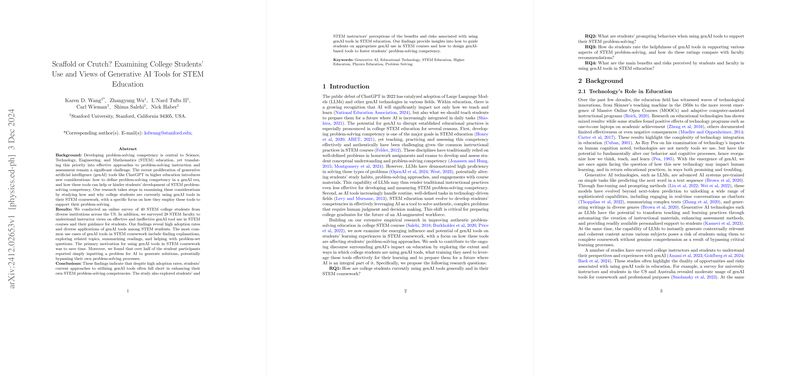Examination of Generative AI Tools in STEM Education: A Balanced Perspective
The manuscript titled "Scaffold or Crutch? Examining College Students’ Use and Views of Generative AI Tools for STEM Education" proposes a nuanced exploration into the adoption and perceptions of generative AI tools, particularly in the context of STEM education. This paper investigates the phenomena embedded within the intersection of advanced AI applications and educational methodologies, catering to the evolving dynamics of STEM learning environments as influenced by generative AI technologies like ChatGPT.
Overview of Study Objectives
The central inquiry of the research delineates several pivotal questions regarding the integration of generative AI in STEM education. Through targeted research questions, the paper elucidates how college students are employing AI tools in their academic pursuits, especially in terms of problem-solving strategies and perceived utility in their coursework. The findings emphasize various student and faculty perspectives surrounding the use of these tools, seeking to establish the benefits and pitfalls perceived by both stakeholders.
Methodology and Participant Demographics
The paper uses a dual-survey-approach to collect data from 40 college STEM students and 28 faculty members, focusing on the use of AI tools across various tasks and disciplines. The researchers carefully curate their samples using diverse institutional backgrounds to strengthen the reliability of their findings. Quantitative metrics and qualitative interviews are employed to achieve a comprehensive understanding of genAI's role in educational processes.
Key Findings
High adoption rates of generative AI tools among students reflect a significant shift in the educational paradigm. Notably, 85% of STEM students reported using such tools predominantly for extracting explanations, assessing related topics, and summarizing academic materials, with a predominant motivation centered on time efficiency.
There exists a salient dichotomy in students' application of AI tools: while some students use AI systems to directly solve problems, others leverage them as scaffolds to inform and concurrently engage in their problem-solving process. This distinction raises important implications for understanding students' epistemic beliefs about AI and its utility in fostering STEM learning competencies.
Further highlighting the disparities, faculty members exhibited caution in espousing the unsupervised use of generative AI tools, particularly regarding problem-solving tasks. This caution stems from a prevalent anxiety about misinformation, reflecting a shared skepticism with students toward the veracity of AI-generated content in learning contexts.
Implications for Education and AI Development
The findings underscore the underlying tension between accessibility and the potential risks of genAI tools in education. The reliance on free versions of these AI tools underscores financial and educational equity concerns, prompting the need for institutional intervention to ensure equitable access to accurate and reliable technological resources.
The divergent views on the helpfulness and application of generative AI tools for problem-solving in STEM amidst students and faculty point to a broader need for pedagogical alignment. Effective integration of these tools would necessitate clear guidelines and training approaches, aiding students in exploiting sophisticated AI capabilities without compromising academic integrity.
Future Directions
The research invites further scrutiny on the relationship between students' beliefs regarding AI facilitators and their educational outcomes, examining how effective prompt engineering and critical evaluation skills can be cultivated. Educational stakeholders must engage in concerted efforts to construct genAI frameworks that embody guided learning experiences over mere solution provision, thus supporting the development of core competencies essential for the AI-augmented workforce of the future.
Ultimately, the authors call for an introspective reevaluation of existing instructional design to incorporate genAI in a manner that reinforces genuine learning, equipping students with robust problem-solving skills essential to navigating the AI-driven educational landscape.
